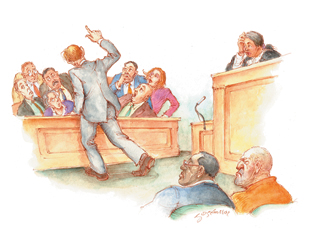How to Make a Losing Argument

Illustration by John Schmelzer
Marty Sanchez’s big employment discrimination case was getting close to trial when he suddenly was bombarded with a cluster of troublesome motions by that new defense boutique firm, Strickland & Michaelman.
So Tuesday evening, Marty was over at the office, where Angus and I were helping him prepare for these last-minute threats.
“Those guys must have been lying in wait for months so they could hit me all of a sudden with these 13 different motions,” said Marty.
“That’s the way ‘Tricky’ Strickland and Joyce Michaelman approached every case when they were at Windstrom & Crusher,” I said. “They’re even worse now that they’ve got their own firm.”
“It looks to me like their motion for a partial summary judgment is the most dangerous one in the bunch,” said Angus. “It seems harmless, but I think it would severely limit how you could prove your client’s damages.”
“I’m loaded for bear on that one,” said Marty. “Let’s start with it.”
I played Judge Standwell while Angus gave a powerful-sounding argument in favor of the defendant’s motion.
The videotape was running when Marty stood up—fire in his eyes—and said, “Your honor, I have 13 compelling reasons why this specious motion should be summarily denied.”
“Sorry to interrupt so soon,” said Angus, “but do you really want to start your argument like that?”
“Absolutely!” said Marty. “Give them some of their own medicine. I’ve got 13 objections to every one of their 13 motions.”
I reached for my pencil to multiply 13 by 13, but Angus had already done it in his head. “You’ve actually got 169 objections to these 13 motions?” he said.
Marty nodded. “It’s poetic justice,” he said.
“But why punish the judge with all those objections for what the defendant is doing?” I said.
Marty stayed in his role. “You’re wrong, judge,” he said. “You do not comprehend what is at issue with the defendant’s dishonest and unethical motions. They present a serious threat to the basic scope and fairness of these proceedings, and my clients are entitled to be heard on them!”
Angus stood up. “Marty,” he said. “Mellow out a little. It’s Tuesday night, and the trial doesn’t start for over a month. But actually I’m glad you said that here and not in Judge Standwell’s courtroom.
“I’m giving a talk for the bar association’s dinner this Friday, called Seven Ways to Make a Losing Argument. And you know what? In less than 30 seconds you already made one losing argument and promised to make another.”
“Oh, come on,” said Marty. “What did I do to make a losing argument?”
“See if you can find it in this list,” said Angus, handing it to Marty:
Argue with the judge
Bury your argument in clutter
Misstate the facts
Base your argument on obscure technicalities
Read your argument
Push a good point too far
Give in to sudden inspiration
“Argue with the judge?” said Marty.
“That’s one,” said Angus. “Jimmy was letting you know that you were taking out your anger on the judge with 13 objections to every motion, and you started lecturing him on his lack of understanding the ‘basic scope and fairness’ of the proceedings. What’s worse, you actually said, ‘You’re wrong, judge.’ You didn’t even call him ‘your honor.’
“Remember: Never argue with the judge, argue to the judge.”
“But what’s the big deal?” said Marty. “I hear lawyers argue with the judge all the time.”
“Do they win?” said Angus.
Marty thought for a minute, then said, “No, but at least they preserve their objections for the record.”
“That and $2.49 will buy you a fast-food double cheeseburger,” said Angus, “but it won’t get the judge reversed on appeal.
“The most important reason for arguing to the judge instead of with the judge is that people like their own ideas. Telling the judge he’s wrong amounts to a personal attack. On top of that, it pushes the judge into adopting your opponent’s position out of self-defense.”
“OK,” said Marty. “What’s the losing argument I promised to make?”
“You promised to bury whatever good points you had in a mountain of clutter,” I said. “It’s theoretically possible you have 169 brilliant objections to make, but I doubt it.”
“I admit I had to stretch to come up with even 15 or 20 decent arguments,” said Marty. “But what’s the harm in tossing a few losers on the judge’s lap? It’s part of the legal tradition. Law schools reward you for coming up with every remotely plausible rule you can think of.”
Angus snorted. “A trial is not a law school examination,” he said. “The problem with making losing arguments is that they become the lowest common denominator by which your whole presentation is evaluated. Judges don’t trust lawyers who make dumb arguments.”
Despite Marty’s enthusiasm, I could see the discussion was taking its toll. So I stood up and said, “The court is declaring a coffee break. As it happens, I have a thermos of dark mountain roast and a box of warm blueberry scones.”
Ten minutes later, Marty said, “Angus, would you mind commenting on the other five ways to make a losing argument before we go on? I’d rather know what to avoid ahead of time than find out the hard way.”
Here are the notes I took:
Misstate the facts. Be scrupulously careful what you say—and how. Judges and juries are suspicious of comments and evaluations you make about the evidence, especially when they’re not supported by the witnesses’ testimony or documentary proof.
One of the difficulties of trying a case with no assistant or co-counsel is there is no one to catch any inadvertent misstatements you make before you hear about them in your opponent’s final argument.
And tell the jurors in your final argument to rely on their recollection of what the witnesses said, and if their recollection differs from yours, to hold it against you and not your client.
Base your argument on obscure technicalities. Jeanne Fleming of Metricus, a jury research firm in Palo Alto, Calif., says, “When it comes to technical matters, most people have a limited attention span. The heart of the case is plot, motive and character.
“When the jury can’t understand what you’re presenting, they turn their attention to something they can understand, particularly motive and character. So don’t make the centerpiece of your case something that doesn’t relate to the interests or abilities of the fact-finders.”
Read your argument. The problem is, no one writes the way they talk—especially lawyers. We can’t resist decorating our compound and complex sentences with words that would send a crossword puzzle editor to the Oxford English Dictionary.
And even if you write with charming simplicity, you are not a professional reader. The results will be awkward and stilted.
So never work from a script. Instead, use an outline and speak extemporaneously—but not impromptu. So what if not everything you say is grammatically correct? It never is anyway.
Push a good point too far. Understatement is more powerful than overstatement. The harder you push—the more you tell people how to think—the more sales resistance you will get from anyone who is listening—especially the judge and jury, who know you’re being paid to convince them.
The problem is, the words you should avoid are the ones that tug at you the hardest: adjectives and adverbs —those exciting, seductive words that keep sneaking into what you write and how you talk.
Stay away from them. They’re poison. With adjectives and adverbs, you’re telling people how to think. Simple verbs and nouns are the workhorses of good speaking and writing. They show, not tell.
Give in to sudden inspiration. You’re in the middle of final argument when out of the blue comes a flash of brilliance. Suddenly you see a connection between events that had eluded you through years of working on the case—until now.
Like a sparkling gem lying on the floor, it calls you. You have found the winning climax for your argument.
The problem is, you only have time to see how to use this great idea—but not to test whether it might turn and bite you.
Take the case of the Illinois farmer who came across the river to shop in St. Louis, where he slipped and fell on the defendant’s floor and seriously injured his back.
During final argument, the defense lawyer thought of a great way to “hometown” the plaintiff. He would appeal to the Missouri sense of resenting out-of-towners who were always trying to take advantage of the home folks. So he worked himself into a serious snit in his argument over “these Illinois farmers who come here trying to put their hands into some St. Louis businessman’s pockets.”
The late Jim Jeans, the St. Louis lawyer who was representing the Illinois farmer, didn’t object. He waited until rebuttal, when he said, “We’re not trying to put our hands into some local businessman’s pocket—we’re trying to put them into the pockets of the Royal Indemnity Insurance Co. that’s defending this case.”
The defense lawyer’s sudden inspiration had opened the door to the admissibility of insurance.
James W. McElhaney is the Baker and Hostetler Distinguished Scholar in Trial Practice at Case Western Reserve University School of Law in Cleveland and the Joseph C. Hutcheson Distinguished Lecturer in Trial Advocacy at South Texas College of Law in Houston. He is a senior editor and columnist for Litigation, the journal of the ABA Section of Litigation.



